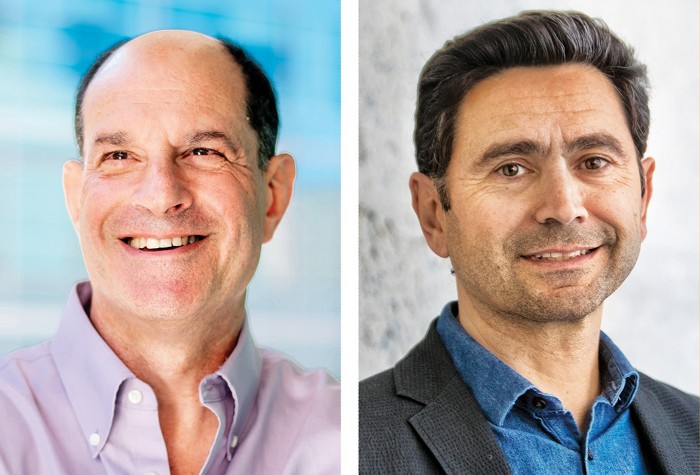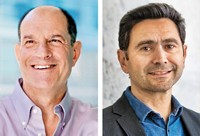Advertisement
Grab your lab coat. Let's get started
Welcome!
Welcome!
Create an account below to get 6 C&EN articles per month, receive newsletters and more - all free.
It seems this is your first time logging in online. Please enter the following information to continue.
As an ACS member you automatically get access to this site. All we need is few more details to create your reading experience.
Not you? Sign in with a different account.
Not you? Sign in with a different account.
ERROR 1
ERROR 1
ERROR 2
ERROR 2
ERROR 2
ERROR 2
ERROR 2
Password and Confirm password must match.
If you have an ACS member number, please enter it here so we can link this account to your membership. (optional)
ERROR 2
ACS values your privacy. By submitting your information, you are gaining access to C&EN and subscribing to our weekly newsletter. We use the information you provide to make your reading experience better, and we will never sell your data to third party members.
Nobel Prize
Discovery of receptors for temperature and touch takes 2021 Nobel Prize in Physiology or Medicine
David Julius and Ardem Patapoutian recognized for their work identifying proteins that convert heat and touch into nerve impulses
by Laura Howes
October 4, 2021

The 2021 Nobel Prize in Physiology or Medicine has gone to David Julius of the University of California, San Francisco and Ardem Patapoutian, of Scripps Research in California for identifying the proteins that detect heat and touch. “This really unlocks one of the secrets of nature,” said Thomas Perlmann, Secretary-General for the Nobel Assembly and Nobel Committee during the prize announcement in Sweden earlier today. Understanding how, at the molecular level, stimuli can be converted into nerve signals, is “actually something that is crucial for our survival,” he added.
The news came incredibly early in the morning for the California-based researchers. On a call with the Nobel Prize organization, Patapoutian described how he missed the call from Sweden because he had his phone set to “do not disturb.” In the end, the news was relayed to him for the Nobel Prize committee by Patapoutian’s 92-year-old father. Meanwhile, Perlmann got through to Julius with help from a relative. "It's quite a thing to be woken up at 2am," Julius told a press conference later that day, "I knew within about 15 minutes that life was going to get pretty busy."
“It is the happiest day of my scientific life,” says Cheryl Stucky, who works on the molecular mechanisms of touch and pain at the Medical College of Wisconsin. She says Julius and Patapoutian’s work “have launched pain and sensory research into the molecular stratosphere,” and today entire fields of research have been built on the work of the two researchers. The next step, she says, is to figure out how to target ion channels including those identified by Julius and Patapoutian to alleviate different forms of pain.

Understanding how we feel temperature and touch began with investigations into the sensation of heat. At UCSF, Julius worked on this puzzle with the help of the molecule capsaicin, which is responsible for the burning sensation that chili peppers deliver. Screening a library of genes from sensory neurons to discover proteins that were sensitive to capsaicin led his team to one specific ion channel, TRPV1, that reacts to both capsaicin and pain-inducing heat (Nature 1997, DOI: 10.1038/39807).

Just a few years later Julius and Patapoutian independently discovered the cold-sensing receptor TRPM8, which is activated by menthol (Nature 2002, DOI: 10.1038/nature719; Cell 2002, DOI: 110.1016/s0092-8674(02)00652-9).
Both researchers have continued to study these TRP channels, but Patapoutian also focused on ion channels that detect mechanical force. The channels his team discovered, called PIEZO1 and PIEZO2, change their shape when the cell membranes they sit within bend in response to a touch or a poke. The change in shape opens the channels, allowing ions to flow across the membrane and generate a signal.
“One of the big reasons why this particular prize was highly appropriate, in my view, is that not only did these two labs discover these proteins, but they have gone to great lengths to explain how they work at an atomic level,” says Michael Caterina, who works on the molecular mechanisms of pain sensation at Johns Hopkins University. Caterina was part of Julius’s team in the 1990s and worked on the capsaicin-sensing ion channel, so he admits some bias, but he adds that “the fact that there may be implications for human disease and the fact that new therapies for pain have been very hard to come by, I think that just add to the impact of this work.”
The role of these proteins stretches beyond touch and temperature sensation says Vera Moiseenkova-Bell who works on TRP channels at the University of Pennsylvania’s Perelman School of Medicine. TRPA1 makes us itch after a bug bite, for one thing, but mutations in other TRP channels are involved in diseases including neurodegenerative disorders and skeletal dysplasia. PIEZO channels don’t just help us feel the world around us but also help control vital functions such as respiration and blood pressure, she says.
There is, Moiseenkova-Bell says, much to be done before drugs targeting these channels find their way into the clinic, but drug developers have been working on it for years. Meanwhile, researchers continue to try to understand these and related ion channels: “There’s a lot of still to be done to understand them at the molecular level,” she says, “but we're getting there.”
Moiseenkova-Bell is clear that the without the work of Julius and Patapoutian, the field she works in would not exist. “It's huge, so I'm so glad,” she says, “they both deserve it.” She also recognizes the work of the trainees and researchers who have passed through the labs of Julius and Patapoutian. “It is always a team effort,” she stresses.
The researchers will share the approximately $1.1 million prize money. Because of the COVID-19 pandemic, both laureates will receive their medals and diplomas in the US rather than travelling to Stockholm in December.
UPDATE: This story was updated on 10/04/2021 to include additional comments from researchers and more information about the early calls from the Nobel Prize organization.




Join the conversation
Contact the reporter
Submit a Letter to the Editor for publication
Engage with us on Twitter